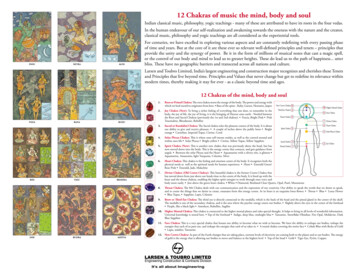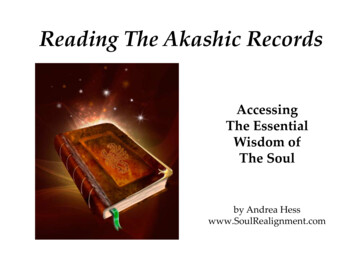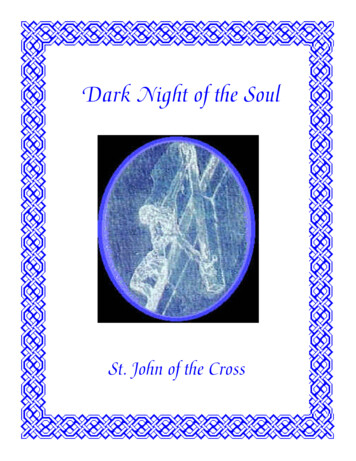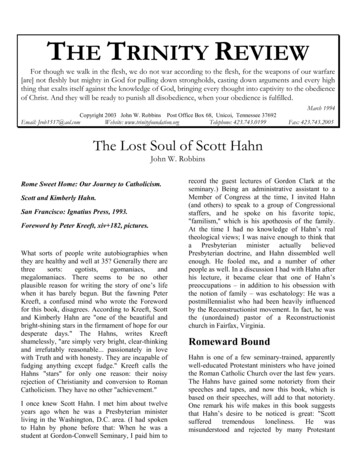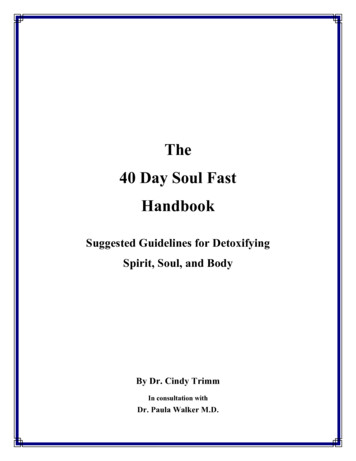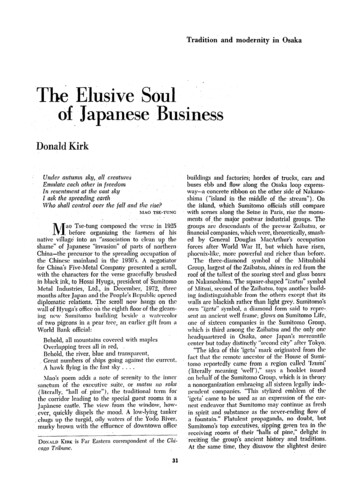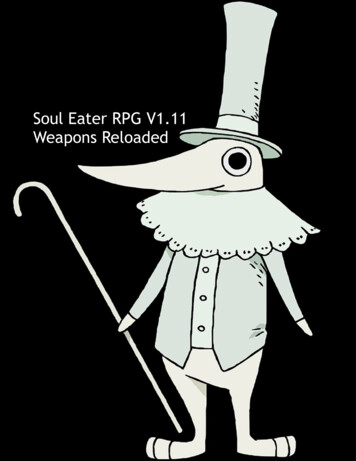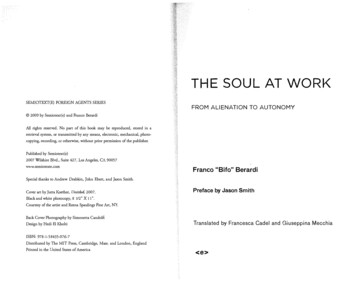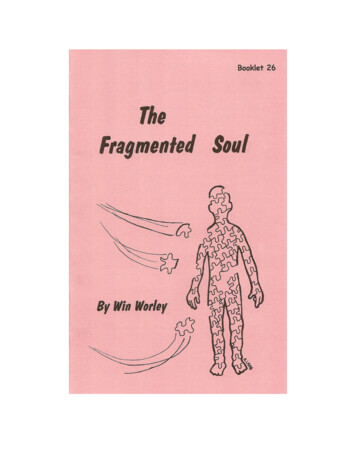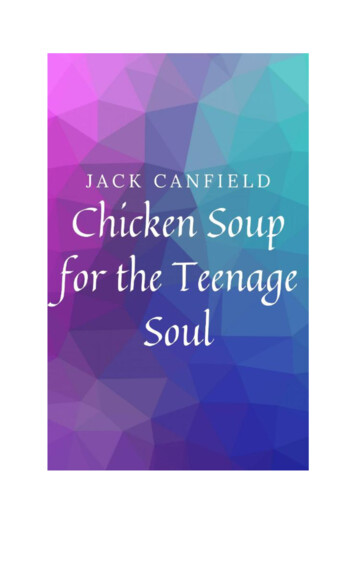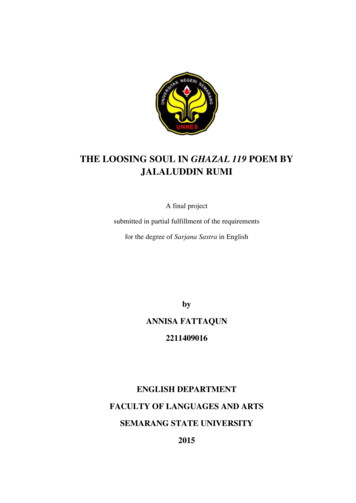
Transcription
THE LOOSING SOUL IN GHAZAL 119 POEM BYJALALUDDIN RUMIA final projectsubmitted in partial fulfillment of the requirementsfor the degree of Sarjana Sastra in EnglishbyANNISA FATTAQUN2211409016ENGLISH DEPARTMENTFACULTY OF LANGUAGES AND ARTSSEMARANG STATE UNIVERSITY2015
MOTTO AND DEDICATION“O you who have believed, seek help through patience and prayer. Indeed, Allahis with the patient”.(QS. Al-Baqarah: 153)“A moment of patience in a moment of anger saves a thousand moments ofregret”.(Ali ibn Abu Talib)If I cannot do any, willingly accept everything, coz it will make me go throughanything.(Annisa Fattaqun)This final project is dedicated to:Myself, Ibu, Bapak, and Eyang
ACKNOWLEDGMENTSFirst of all, Praise to Allah God Almighty and His prophet, Muhammad (Peace Beupon Him) for all the blessings that I have received during the process of makingthis final project until it is finally completed.I would like to express my sincerest thankfulness to my supervisors, Mrs.Fatma Hetami, S.S., M.Hum. as the first supervisor for his patience in providingcontinuous guidance, suggestions, and support during her consultations for thisdraft. I would like to express my great gratitude to Mr. Dr. Rudi Hartono, S.S.,M.Pd. my second supervisor, for his corrections and suggestions in thefinalization of this research report. I would also like to express my great gratitudeto Mohamad Ikhwan Rosyidi, S.S, M.A, as the examiner, for his sincere goal toteach, thus I realized my thesis shortage and I have more knowledge of poetry.My sincere, honor, and thankfulness are also addressed to all lecturers of theEnglish Department of Unnes who have given beneficial and priceless knowledgeto me during my study in Unnes.In this occasion, I would like to dedicate my deepest gratitude to my mother,father, uncle, auntie, and my siblings for their endless love, supports, and prayers.Their supports gave me the extra motivations that I needed to complete this extraproject. Thank you and I love you.Thank also for myfriends of literature students class of 2009, especiallyAjeng, Ovi, Neli, and Karin who had given me the best experiences, and valuablelessons in many aspects, and do not forget my thankfulness to myself who hadstruggled to finish this final project.i
ABSTRACTFattaqun, Annisa. 2015. The Loosing Soul in „Ghazal 119‟ Poem by JalaluddinRumi. Final Project. English Department. Languages and Arts Faculty. SemarangState University. First Advisor: Fatma Hetami, S.S., M.Hum.Second Advisor:Dr.Rudi Hartono, S.S., M.Pd.Keywords: soul, loosing soul, ghazal, poemThe loosing soul became my concern to analyze Rumi‟s Ghazal 119 poem,because the soul which ought to be used in living life was not fully active withdaily activity in modernism. The soul which lost the essence of sweetness andtenderness might affect one‟s characters. In addition, the objectives of this studyare to describe the loosing soul in Rumi‟s Ghazal 119 poem and explain therepresentation of Rumi‟s unconsciousness. The research design was qualitativedescriptive design because it used multi-method in focus, involving aninterpretative, naturalistic approach to the case study by collecting information.Moreover, the analysis was focus on the literature itself, so the data which wasimplied on the analysis was the content analysis that was used as the researchinstrument. The main source of the analysis was Ghazal 119 poem, and secondarysources were taken from dictionaries, articles, journals, e-books, and books. Indata collection technique I used documentation to collect the information, and thedata analysis, I used interactive model of data analysis. By this, important data canbe compiled and used for the analysis.By this, the result was found that the loosing soul was described by usingnew criticism which focused on the text of the poem and intrinsic elements whichwere considered, consisted of sound, language, form, and meaning of poetry.Moreover, the representation of Rumi‟s unconsciousness was found by usingpsychoanalysis criticism, and the result of Rumi‟s unconsciousness had beendiscovered as the way of thinking which was influencedby the soul.It can be concluded that the poem did not interact directly to the loosingsoul, but it used the representation of the loosing soul through the bad charactersand behavior of the narrator‟s companion. Intrinsic elements helped to reveal thecharacteristics of the loosing soul through the sound, language, sound, andmeaning of the poem. Furthermore, the analysis of the loosing soul had alsorevealed Rumi‟s unconsciousness by using Jung‟s point of view. Rumi‟sunconsciousness had been discovered as the way of thinking which wasinfluenced by the soul. In addition, the way of thinking would also affectsomeone‟s characters and choice of life. Thus, soul must be filled with sweetness,tenderness, and spiritualism, and by this people have purpose in living life andthey will not feel empty by doing activity.ii
TABLE OF CONTENTSACKNOWLEDGMENT .iABSTRACT . iiTABLE OF CONTENTS . iiiLIST OF APPENDICES .vLIST OF FIGURES .viCHAPTERI.INTRODUCTION1.1 Background of the Study . 11.2 Reasons for Choosing the Topic . 31.3 Statement of the Problem . 31.4 Objectives of the Study . 41.5 Significance of the Study . 41.6 Outline of the Research . 4II.REVIEW OF RELATED LITERATURES2.1 Review of the Previous Study . 62.2 Review of Related Literature . 72.2.1 Soul, Loosing Soul, Ghazal . 72.2.2 New Criticism . 92.2.3 Psychoanalytic Criticism . 112.3 Theoretical Framework . 16III.RESEARCH METHODOLOGIES3.1 Research Design . 19iii
iv3.2 Research Instruments . 203.3 Characteristic of Research . 213.4 Data Collection Technique . 213.5 Role of Researcher . 223.6 Data Analysis . 22IV.RESULT AND DISCUSSION4.1 The Loosing Soul Described . 264.1.1 The Loosing Soul in Sound . 264.1.2 The Loosing Soul in Language . 304.1.3 The Loosing Soul in Form . 394.1.4 The Loosing Soul in Meaning . 434.2 The Representative of Rumi‟s Unconscious . 44V.CONCLUSION AND SUGGESTIONS5.1 Conclusion . 475.2 Suggestion . 48BIBLIOGRAPHY . 49APPENDICES . 52
LIST OF APPENDICESAppendix 1: The Poem of Ghazal 119 by Jalaluddin Rumi . 53Appendix 2: The Loosing Soul in Sound . 54Appendix 3: The Loosing Soul in Language . 55Appendix 4: The Loosing Soul in Form . 56v
LIST OF FIGURESDiagram 2.1: Theoretical Framework . 17Diagram 3.1: Interactive Model of Data Analysis . 22vi
CHAPTER IINTRODUCTION1.1 Background of the StudyIn this era, modernism is the hot topic to discuss. It always relates to all newthings, and in term of technology and science, they always are renewed andchanged. Besides, the facility and all will always be developed. Meanwhile, in thecontrary, old things only be history, and tradition. Focusing in term of society,there are some differences between these two things. Traditional society seriouslybelieves in religious direction, they do not believe in technology and science, theytend to use traditional method of medicine, they also attach more in cultural andphilosophical values, and they have joint family system of living. Otherwise,modern society tend to relax in term of religion, they know better in technologyand science, even they are the inventor of the new technologies so that theybelieve in modern medical treatment which use the newest science knowledge andtechnology, modern society do not pay much attention in cultural, and theyconsider most on individual family system of living (Aron, 2011). Between two ofthem, there is no better or worse on one side because both of them haveadvantages and disadvantages such as in term of technology and science, but itlacks in believing religion. Moreover, in this modern era, there is still traditionalsociety who keeps the tradition (as people call it so). So, not all society isfollowing modernization, and there are people who have balance live between1
2modern and traditional living. In line with modernism field, I tried to highlight thebalance of living between term of modernism and traditionalism.The best balance of living is using the advantages of both terms, modernand tradition. In my concern, the best part of the traditional living is using theheart and soul to communicate and do everything. Meanwhile the best part of themodern living is the easier way to life. Therefore, my concern led me to find theuse of soul within daily activity in this modern era in which sometimes the soulwas separated from daily activity and cause numb on some people in living life.The literature that conveys similar topic is Ghazal 119, a poem by JalaluddinRumi. I was interested in using poem as the main literature due to the beautifulcombination of the diction, rhyme, rhythm, and form that conveyed the meaningof poetry to imply the message. The poem was taken due to the concrete wordsthat were used by the poet. Jalaluddin Rumi, the poet, “was perhaps the finest poetof all time and a great influence on Muslim writing and culture, his poetry is wellknown throughout the modern world, and he is one of the best selling poets inAmerica” (BBC, 2009). His writing is an amazing craft that attracts many peopleto read, due to his concrete word of using and easy understanding poem. One ofhis poems was Ghazal 119 poem. Ghazal in Sufism context had been known aslove divine poem. Ghazal is a form of lyrical poetry that gives some kind ofmessage about the beauty of God, or God‟s creation. Nevertheless, in this poem Idiscussed more about the loosing soul which can be proved by the symptoms ofbehavior. Behavior and soul are related to each other. For some people who had
3behavior in certain way explain the soul condition inside them. It explained howthe loosing soul participates in someone‟s life.In line with the explanation above, I was interested in taking “The LoosingSoul in Ghazal 119 Poem by Jalaluddin Rumi” as the title of my final project. Ianalyzed how the loosing soul described in Rumi‟s poem and the impact of it.1.2 Reasons for Choosing the TopicThe reason for choosing the topic is because the Ghazal 119 poem denotedsomeone‟s characters and personality which unconsciously represented theloosing soul. Even though the loosing soul was described indirectly, it influencedsomeone‟s characters and behavior. In addition, soul is the centre energy whichinfluence the way of human‟s certain thinking to behave and perform in theoutside. So, whenever someone‟s behaviors are not performing how it ought to be,it may lead to the essence of the loosing soul. Moreover the soul and Ghazal havesimilar relation. They related to the divinity and the process of them influence thecharacters and personality which was described in the poem. Thus, the loosingsoul as the core of characters influence became the main topic of my final project.1.3 Statement of the ProblemThere are also some statements of the problem as follows1. How is the loosing soul in Rumi‟s Ghazal 119 poem described?2. What is the representation of Rumi‟s unconsciousness?
41.4 Objectives of the StudyAccording to the problems above there are also some purposes of the study asfollows1. To describe the loosing soul in Rumi‟s Ghazal 119 poem.2. To explain the representation of Rumi‟s unconsciousness.1.5 Significance of the StudyThere are some significances of the study. Firstly, this study was written to fulfillthe obligation as the students of literature program. In addition within this study, itmay help the readers to understand more about the point of soul and how the soulhelps our performance around society. This study may also help the readers toacknowledge that the soul also influences our behaviors and performance.The second, writing this study helped me to acknowledge more theposition of soul in our life, and helped me to be someone better in behaviors andpersonalities. The soul is not only inside human being but also exist side by sidein living life. Theoretically, I learned how to write academic writing, and analyzedeeper a literature. Likewise the usage of a theory by Carl G. Jung, I learned moreabout the psychoanalytic criticism by using his point of view.1.6 Outline of the ResearchThere is outline of the research to make the report of the analysis easier asfollows,Chapter I provides introduction that consists of background of the study,reasons for choosing the topic, statements of the problem, objectives of the study,significance of the study, and the outline of the research.
5Chapter II providesreviews of related literature which can supportthewriting of the report. It discusses the previous studies, intrinsic elements ofpoetry, psychoanalytic criticism, soul, loosing soul and Ghazal, and theoreticalframework.Chapter III provides research methodology. It presents research design,research instruments, data collection and data analysisChapter IV is the result and discussion, this chapter elaborates the loosingsoul and the representative of Rumi‟s unconscious.Chapter V is the last chapter. It presents conclusion of the main pointsfrom the result of the study. This chapter also provides some suggestions, whichare relevant to the topic. The bibliography and appendix are given in other pages.
CHAPTER IIREVIEW OF RELATED LITERATURE2.1Review of the Previous StudyThere was similar topic as I analyzed. In 2008, Bill Plotkin published book, titled“Nature and the human soul”. The book introduced an innovative developmentalpsychology that showed how fully and creatively we can mature when we allowedsoul and wild nature to guide us. Plotkin presented a model for a human life spanrooted in the patterns and rhythms of wild nature, a template for individualdevelopment that ultimately yields a strategy for cultural transformation. Therewas another book which was written by Roger Housden. The title was “TenPoems to Open Your Heart”. The book contained the compilation of poemsanalysis which related to love, soul, and divinity. The book devoted to personallove, other‟s love, and to the love that embraces both this world and the next. Oneof the poems can open, gladden your heart (Houdsen, 2003).By searching the previous studies above, there were similarity variableswhich discussed about soul. Nevertheless, in my analysis, I elaborated the loosingsoul which existed in the poem and how this loosing soul described in the poem.In addition, my analysis used the characters and behaviors as the representative ofthe loosing soul which was shown in the poem.6
72.2 Review of Related LiteratureAnalyzing the topic needed media of approach or theories to analyze the literarywork. The usages of approach were new criticism and psychoanalytic criticism.Besides the media to analyze, I also elaborated the variable of soul, loosing souland Ghazal in this section.2.2.1Soul, Loosing Soul, and GhazalThere are some variables that must be understood in this study, they are soul, theloosing soul and Ghazal. Soul is philosophy words which is hard to explainscientifically. According to Plato in Crivellato and Ribatti (2006) divine soulcalled logos, and it related to the head which dominates the rest of the body, andthe whole body was given as servant. According to Aristotle in Crivellato andRibatti (2006) “the soul is defined as the substance or the form of a living body. Itis indeed the primary cause of living, perceiving and thinking” (p. 331). Hedistinguished different soul faculties. The vegetative or nourishing soul belongs toboth plants and animals. Sensitive and motor souls pertain only to animal, and theintellectual soul is limited to man.All soul faculties reside in the heart. Soul is as regards its characteristic ofuniting the blameworthy qualities of man. The blameworthy qualities are theanimal powers in man that are opposed to his rational powers. It is thus, likePlato‟s irrational soul, made up of anger and appetence. The second meaning ofsoul is that subtle spiritual substance which is the real essence of man (AlGhazali, 2010). Although the definition and elaboration of the soul is different,the essence of the soul is the same. Soul is part of the highest element of human
8being which different from animal and plant or other creature. Soul gives theconscious element of human being to reach the divinity. Human being needs thesoul in good spiritualism to reach the high quality as a human. Meanwhile theloosing soul which existed in the topic was different from the soul whichexplained above. The loosing soul was not the same meaning as the lost soul, butit meant that the essence of soul is missing. The reason why the soul feels numb isbecause it lacks the spiritualism activity so that‟s why the topic was written as theloosing soul.Ghazal is form of lyrical poetry. Ghazal firstly developed in Persian, thenin Urdu, now also in other South Asian languages (Shackle, n.d). Shackle wrotethat Ghazal “was cultivated by courts poets which evolved ingeniously ambiguouscombination of human romance with mystical love for the divine” (p.2).According to Shackle (n.d) “Ghazal is defined as a poetic genre by its formalfeatures, for whose description there is a traditional set of technical terms ofmostly Arabic origin, quite distinct from the traditional vocabulary of Indianpoetics” (p.3). Another source from Campo (2009) stated that Ghazal can be“interpreted both as a love poem and devotional poem, for the pain of separationthat one‟s lover is analogous to the pain of separation one feels from god” (p.260).More or less Ghazal is defined as the love poem to god which gives the maintheme as divinity overall.The relation between the three variables above was divinity andspiritualism, which the soul was the highest spiritualism of human being reachingthe divinity, and Ghazal is also a kind of love poetry genre tells about divinity. So,
9the divinity and spiritualism was essence of the real soul to concern but the mainfocus of the poem was about behavior and characters which represent the loosingsoul.2.2.2New CriticismNew criticism known as an approach to literary analysis provides the reader witha formula for arriving at the correct interpretation of a text using only the textitself. New criticism saw the internal working of the literary text as its owncontext. New critical analysis or new criticism emphasizes the complexity ofmeaning, the study of structure and pattern in literature and emphasizes theimportance of immanent textual interpretation as opposed to contextual analysis.New Criticism is also known for advancing close reading, detailedattention to how a text is written and how it constitutes meaning at variouslevels, which is close reading concerns close attention to textual detailswith respect to elements such as setting, characterization, point of view,figuration, diction, rhetorical style, tone, rhythm, plot, and allusion(Rapaport, 2011, p. 36)It can be described that the main focus of new criticism is the text of a poem, andfor uncovering the poem, it needs to consider the elements such as setting,characterization, point of view, figuration, diction, rhetorical style, tone, and etc.Another definition of new criticism is from bressler,new critics assert that only the poem itself can be objectively evaluated,not the feelings, attitudes, values, and beliefs of the author or the reader.The New Critics belong to a broad classification of literary criticism calledformalism. Being formalists, the new critics espouse what many call „thetext and text alone‟ approach to literary analysis (Bressler, 1999, p. 39).
10According to Bressler (1999)"a good critic examines a poem‟s structure byscrutinizing its poetic elements, rooting out and showing its inner tensions anddemonstrating how the poem supports its overall meaning by reconciling thesetensions into a unified whole” (p. 46). So, by using intrinsic elements of poetrycan support to uncover the overall meaning of a poem.From a new critical perspective, discovering the correct interpretation of atext is by reading the poem several times and by carefully noting the work‟s titleand its relationship to the text. Then, by following the prescribed steps listedbelow,1. Examining the text‟s diction. Consider the denotation, connotation andetymological roots of all words in the text.2. Examining all allusions found within the text by tracing their roots to theprimary text or source, if possible.3. Analyzing all images, symbol and figures of speech within the text. Note therelationships, if any, among the elements, both within the same category(between images, for example) and among the various elements.4. Examining and analyze the various structural patterns that may appear withinthe text, including the technical aspects of prosody. Note how the poetmanipulates metrical devices, grammatical constructions, tonal patterns andsyntactic patterns of words, phrases, or sentences. Determine how thesevarious patterns interrelate with each other and with all elements discussed instep 1 to 3.
115. Considering such elements as tone, theme, point of view, and any otherelement-dialogue, foreshadowing, narration, parody, setting, and so forth- thatdirectly relates to the text‟s dramatic situation.6. Looking for interrelationship of all elements, noting where tensions,ambiguities or paradoxes arise.7. After carefully examining all elements, state the poem‟s chief overarchingtension and explain how the poem achieves its dominant effect by resolvingall such tensions.2.2.3Psychoanalytic CriticismAccording to Green and LeBihan (1996) “the relationship between psychoanalysisand literature can be looked at in different ways, but we can reduce it to a questionof what is being subjected to the analytic process, and what repressed meaning wethereby hope to uncover” (p. 143). This statement clearly mentions thatpsychoanalysis and literature can be used in the textual or contextual meaning touncover the object. So, this statement supported the research to usePsychoanalysis focus on the literary work.According to Green and LeBihan (1996) “the relationship betweenpsychoanalysis and literature can be looked at in different ways, but we canreduce it to a question of what is being subjected to the analytic process, and whatrepressed meaning we thereby hope to uncover” (p. 143). This statement clearlymentions that psychoanalysis and literature can be used in the textual orcontextual meaning to uncover the object. So, this statement supported theresearch to use Psychoanalysis focus on the literary work.
12According to Jung in Bressler (1999) human behavior is driven by dreamsand dreams include mythological images which are driven by unconsciousness.Jung theory was used, due to the similarity between the concept of characters inthe discussion and the concept psyche of Jung. First of all, the concept of Jungabout human psyche is distinguished into three levels. They are consciousness, thepersonal unconscious and the collective unconscious (Jung, trans. 1959).According to Jung, consciousness does not create itself – it wells up fromunknown depths. In childhood it awakens gradually, and all through life itwakes each morning out of the depths of sleep from an unconsciouscondition. It is like a child that is born daily out of the primordial womb ofthe unconscious. It is not only influenced by the unconscious butcontinually emerges out of it in the form of numberless spontaneous ideasand sudden flashes of thought. (Luton, 2010, para.5)It absolutely said that consciousness is waking state which is arising out of theunconsciousness. “Conscious is primarily an organ of orientation in a world ofouter and inner facts” (Jung, trans. 1969, p. 123). Consciousness relates to theego, which the ego is the centre field of consciousness, and the subject of allpersonal acts of consciousness (Jung, trans. 1959). Meanwhile, the personalunconscious is the receptacle of all lost memories and of all contents that are stilltoo weak to become conscious, more or less it include intentional repressions ofpainful thoughts and feelings (Jung, trans. 1969). According to Jung (1969)personal unconscious is “made up of individual and more or less unique contents”(p. 134). Consciousness became unconscious because firstly, the consciousmemory lost its intensity and were forgotten or because consciousness waswithdrawn (repression), and secondly; some of the sense-impressions, which
13never had enough intensity to reach consciousness but somehow have entered thepsyche (Jung 1969). The third, psyche by Jung is collective unconscious.According to Jung (1969) Collective unconscious is “a deposit of world-processesembedded in the structure of the brain and the sympathetic nervous system, itconstitutes in its-totality a sort of timeless and eternal world-image whichcounterbalances our conscious, momentary picture of the world” (p. 376).Collective unconscious is ancestral heritage which belong to human, like Jungexplained that “the collective unconscious, however, as the ancestral heritage ofpossibilities of representation, is not individual but common to all men, andperhaps even to all animals, and is the true basis of the individual psyche” (Jung,trans. 1969, p. 152). So, the collective unconscious belongs to all men as theancestral heritage about the world. Moreover, the images of the ancestral heritageabout mythology in collective unconscious which appear often, as the result ofparticular influences, tradition, and excitations working on the individual, is calledthe archetypes (Jung 1969).Jung‟s work mostly indicate subconscious realm, especially the collectiveunconscious and archetypes which relate to the behavior. Jung (1969) explainedthat “the collective unconscious consists of the sum of the instincts and theircorrelates, the archetype. Just as everybody possesses instincts, so he alsopossesses a stock of archetypal images” (p. 138). Instinct and archetypes aredifferent type mode. Jung (1969) said “instincts are typical modes of action andwherever we meet with uniform and regularly recurring modes of action andreaction we are dealing with instinct, no matter whether it is associated with a
14conscious motive or not” (p. 135). And, archetypes “are typical modes ofapprehension and wherever we meet with uniform and regularly recurring modesof apprehension we are dealing with an archetype) no matter whether itsmythological character is recognized or not” (p. 138). Jung (1969) explained that“the most powerful ideas in history go back to archetypes” (p. 158). Archetypeshave big role to influence, control and even suppress the ego-personality ofhuman behavior because the total personality can be affected by the archetypesthrough a process of identification. In the line of human behavior and personality,the highlighting case is the archetypes and its motifs (Jung, trans.1969).Thus,archetypes are part of the collective unconscious which has spiritual heritageto translate into visible reality of the world.Jung identified four major archetypes, but also believed that there was nolimit to the number that may exist (as cited in Cherry, n.d). The major archetypesare the shadow, the anima and animus, the persona, and the self. According toJung (1959) the shadow is “a moral problem that challenges the whol
To describe the loosing soul in Rumi‟s Ghazal 119 poem. 2. To explain the representation of Rumi‟s unconsciousness. 1.5 Significance of the Study There are some significances of the study. Firstly, this study was written to fulfill the obligation as the students
